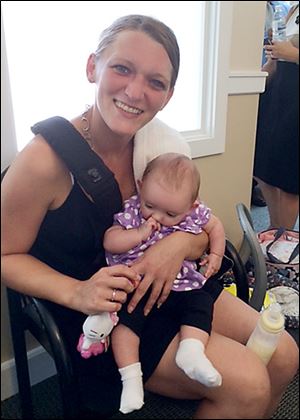
FEATURED EDITORIAL
The right prescription
Ohio doesn’t need to reinvent the wheel to expand effective drug treatment — it needs to support what works
8/8/2014
Jamie Shipley, 28, a recovering heroin addict, holds her 4-month-old daughter, Kaylee, at First Step Home in Cincinnati.
Even with Gov. John Kasich’s prudent expansion of Ohio’s Medicaid program, the state continues to spend far too little — roughly $114 million a year — on alcohol, drug, and addiction services. If that sounds like a lot of money, consider that Ohio spends $1.5 billion a year to operate its prison system, which holds thousands of drug offenders.
As the state’s opioid and heroin epidemic continues to grow, as few as 1 in 10 Ohioans who need treatment gets it. Moreover, the quality and scope of that treatment varies greatly, ranging from bare-bones detoxification programs to comprehensive plans to meet the medical, social, economic, and psychological needs of people who are preparing for long-term recovery and successful lives.
Click here to read more Blade editorials.
The problem is not knowing what works. Integrated treatment programs that draw on communitywide resources to treat addiction, provide therapy, help clients find jobs and education, and arrange safe, stable, and affordable housing have proven most successful.
The state doesn’t need to reinvent the wheel as it looks to expand effective drug treatment. Agencies around Ohio offer plenty of examples of best practices.
One such initiative is the Maternal Addictions Program run by First Step Home in Cincinnati, where opiate-addicted mothers give birth to healthy babies while they start their long-term recovery. The agency is part of a $4.2 million pilot project launched by the state this spring that aims to reduce typical hospital stays for drug-addicted babies by 30 percent.
The three-year program — a partnership of the governor’s office, Ohio Medicaid, and the state Department of Mental Health and Addiction Services — includes early identification, counseling, and medication-assisted treatment.
The Maternal Opiate Medical Support (M.O.M.S.) project aims to help 300 women and babies who are addicted to heroin and prescription painkillers in Athens, Cleveland, Columbus, and Cincinnati.
Some funding for M.O.M.S. covers vouchers for housing, transportation, baby-sitting during treatment, and other important supports for recovery.
In Cincinnati this week, 28-year-old Jamie Shipley, holding her 4-month year-old daughter, told state officials how First Step had gotten her off heroin and into medication-assisted treatment.
She said the program ensured that she delivered a healthy baby, provided stable housing on the First Step campus in Cincinnati’s Walnut Hill neighborhood, and helped her get a job as a waitress. She learned how to write a resume and received clothes from the Dress for Success program in Cincinnati.
First Step, which recently got a state grant of nearly $300,000, started its Maternal Addictions Program in 2011, after the agency started serving more pregnant women with a drug addiction. Providing medication-assisted treatment such as Suboxone has nearly doubled, to 75 percent, the share of women who successfully complete the program.
But First Step Chief Executive Officer Margo Spence and Vice President Terry Schoenling knew that long-term recovery would take more than treating addiction. “We recognized that it would take a holistic approach, encompassing everything from housing to work to medication-assisted treatment to parenting skills and nutrition,” Mr. Schoenling said this week.
The state treats roughly 30,000 people a year for opioid addiction. It needs not only to expand treatment capacity, but also to ensure that the treatment it provides is effective, with proven results. That means offering intense support services that addicts need to become productive and contributing members of society.
It won’t be cheap, but the alternative is far more costly: Tens of thousands of Ohioans remaining in the throes of addiction while continuing to drain the state’s social service, medical, and criminal justice systems.